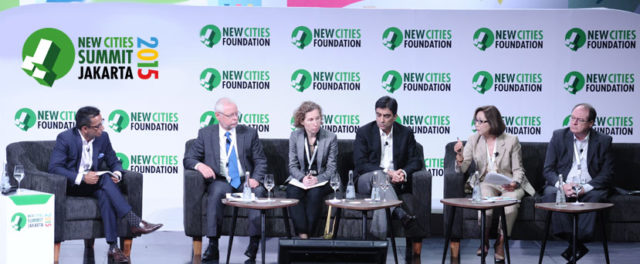Bridging the Urban Investment Gap
August 3, 2015 — Blog
This post is part of our Seizing the Urban Moment discussion series, following the fourth edition of the New Cities Summit in Jakarta in June 2015.
At the start of this session dedicated to urban financing challenges, Arvind Satyam, Managing Director, Global Business Development, Internet of Everything Group at Cisco, set the stage by reminding the audience how city representatives throughout the Summit had been crying out for more investment. Transportation, sewerage, connectivity and healthcare all need modern infrastructure, which is costly for any government – especially in developing countries.
The Deputy Mayor of Budapest, Gabor Bagdy, said his city has been fortunate. It can rely on European Union funding to build its infrastructure. “We can tap into European Union finance,” he said, and “we also have the opportunity for the remaining part funded by the EIB [European Investment Bank].”
Cape Town, South Africa, is not in the same position. It could have focused on pursuing projects which appeal to investors, said Deputy Mayor Ian Neilson, but that would not help achieve the city’s broader socio-economic aims, he explained. “We rely on balance sheet funding and on the overall strength of the city. Lenders look at the overall balance sheet rather than a particular project. That means that the city must be well-run,” he said.
Julie Kim, Senior Fellow at NewCities, said the problem is not a lack of funding but a lack of “bankable projects”. Cities need to have clear policies, low regulations and credibility in international insurance markets, she said. “The most critical gap is in the early project preparation stage, where cities take their visions and translate them into actual projects for investors,” she noted. More support is required from NGOs and other institutions here.
Najeeb Haider of Citi agreed, noting that it is vital that infrastructure schemes have legal structures that are planned in advance, and that cities have clarity over what is expected in contracts. He also outlined that the key priority for structuring infrastructure financing is the allocation of risks.
Another problem, however, is that some cities face scale issues where they are too small for investment, Kim said. Here, she suggested that they club together to raise “multiple investments for multiple cities”.
Ultimately, “there is no such thing as free money” – and taxpayers should face more of the burden, added Kim. Elena Bourganskaia, Senior Manager – Global Cities at the International Finance Corporation agreed, calling on cities to start charging citizens for water usage so that the money can be invested elsewhere.
Bourganskaia also emphasized that financing of infrastructure should be shared by local government and the private sector. However, among 500 cities in emerging markets, “only 5% have any sort of credit rating that is internationally recognized” whilst in many countries, cities are not allowed to borrow at all. National governments do more to facilitate access of municipalities to capital markets, Bourganskaia argued.

Speakers
Gábor Bagdy, Deputy Mayor, Budapest
Elena Bourganskaia, Senior Manager, Global Cities, International Finance Corporation – @IFC_org
Najeeb Haider, Managing Director, Head of Project and Infrastructure Finance, Citi – @Citi
Julie Kim, Senior Fellow, Infrastructure Finance Initiative, NewCities – @newcitiesfound
Ian Neilson, Executive Deputy Mayor, Cape Town – @ianneilson
Moderator: Arvind Satyam, Managing Director, Global Business Development, Internet of Everything Group, Cisco – @ChasinArv / @Cisco